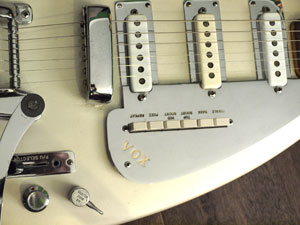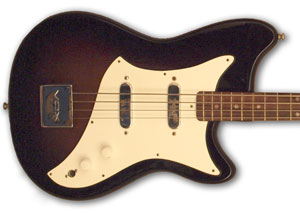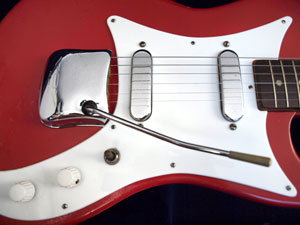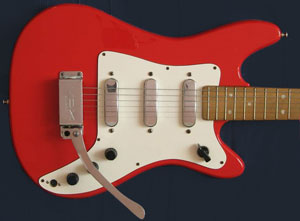
Vox produced solid body guitars in the UK from 1961 until 1967, in Italy between 1965 and 1969, and Japan from 1969 onwards. Different guitars were available to different markets at different times. Initially JMI-made instruments were exported worldwide, but the Dartford plant could not fill demand. From the mid 1960s US guitar stores were stocking Vox guitars made in Italy by EME - a consortium made up of JMI, Thomas Organ co. and Italian guitar company Eko, whilst British Vox's were still produced by JMI. The two plants made noticeably different guitars.
Vintage Vox solid bodies like the teardrop-shaped Mark VI and the Phantom have made Vox guitars famous, and were produced separately in Britain and Italy, but there were very many lesser-known models produced throughout the 1960s, some of which sold in large numbers, like the Shadow, Stroller and Clubman, whilst some are incredibly rare, like the Apache and Scorpion.
The very earliest British instruments bear a remarkable similarity to certain early sixties models made by Fenton Weill; it is not clear whether these were manufactured by them, or a third company produced for both. Supposedly, Two UK furniture manufacturers (Stuart Darkins and then later, G-plan) produced Vox bodies and necks which were then assembled with Vox electronics at the Vox Dartford factory. It is tempting to suggest the differing models with the same names shown in the 1962 Vox Catalogue and 1963 Vox Catalogue represent the work of each company, although this is pure conjecture. Certainly Vox solid bodies were being produced at Dartford by 1965, at least to some extent. Certainly numerous prototypes and test models were made including the one-off Vox Kensington made for the Beatles.
The names of Vox guitars are quite interesting in themselves. Some clearly have musical references: Soloist, Duotone, etc. The name Soundcaster is clearly derived from Stratocaster, as was the instrument itself. Likewise Shadow almost certainly refers to the early sixties British band of the same name - actually THE biggest band in Britain at the dawn of the 1960s, and Vox endorsers too. Others are not so clear, but with the second world war still looming large in the minds of British citizens, it may be that many of these guitar names have military origins. During world war two there were British naval vessels named HMS Ace, HMS Consort, HMS Escort, and American aircraft named Phantom, Dominator, Apache, Scorpion and Marauder.
The JMI plant in Dartford could not keep up with worldwide demand, and production of additional solid body models was allocated to the Eko factory in Italy from 1965. As well as the much desired Mark (teardrop) and Phantom models, Eko produced a range of models not dis-similar to the UK Consort, and all named after British world war two aircraft (with the possible exception of the Vox Harlem): the Meteor (Gloster Meteor), Hurricane, Tempest (Hawker Hurricane & Tempest), Spitfire (Supermarine Spitfire), Bulldog (Bristol Bulldog, actually slightly pre-war), Super Meteor, and Harlem.
By 1967, with demand increasing still, a new plant was set up in Italy, producing a redesigned, but significantly slimmed down range of Vox guitars. This was in conjunction with JMI, Eko, and US distributor Thomas Organ, and was known as EME. The new solid body models were based on existing designs: the Phantom-styled Delta, Bulldog-styled Invader and Fender/Vox Consort-styled Thunderjet V260. Again, these three models had aircraft origins, but with production very much focused on the USA, American planes were chosen: Convair Delta Dagger, Douglas Invader and Republic Thunderjet.
Some of these guitars, both British and Italian, were fitted with built-in electronic effects, and it is perhaps these as much as anything that give Vox guitars their distinctive sounds.





Right at the end of the 1960s, Vox sold a number of rebadged Japanese instruments under the Vox marque. These included the Les Paul style sold body VG2.
$5500
$4499
$4490
$3100
$2999
$2195
$570
$550
€2000
€1853
$774
£750
€698
£600
£599